Hard metal


Alfonso VIII of Castile
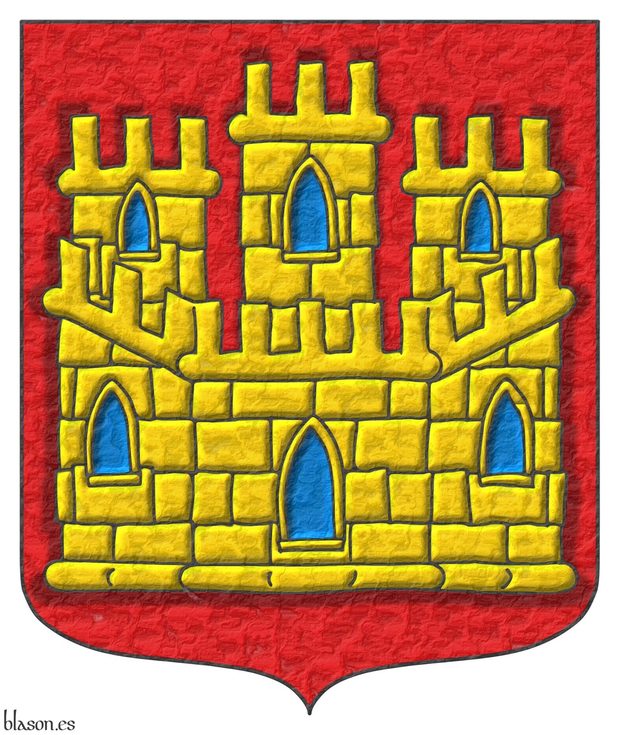
Born on November 11, 1155, in Soria and died on October 6, 1214, in Gutierre-Muñoz, Avila.
Gules, a castle triple towered Or, port and windows Azure, masoned Sable.
Escudo de gules, un castillo de oro, aclarado de azur, mazonado de sable.
Existing arms interpreted by me as follows: the shield’s shape is pointed and rounded; the field has been enameled Gules; the castle is outlined, illuminated, and shaded; the whole composition features a heavily hammered metal finish.
This ancient coat of arms of Castile can be consulted, among other sources, in [Argote de Molina, G.; 1588; chapter XLII].
Blazon keywords: Without divisions, Gules, Or, Azure, Sable, One, Castle, Port and windows and Masoned.
Style keywords: Ogee, Illuminated, Shaded, Outlined in sable and Hard metal.
Classification: Interpreted, Personal, Coat of arms and Kingdom of Castile.
Bearer: Alfonso VIII of Castile.


Almorrabides of Navarre
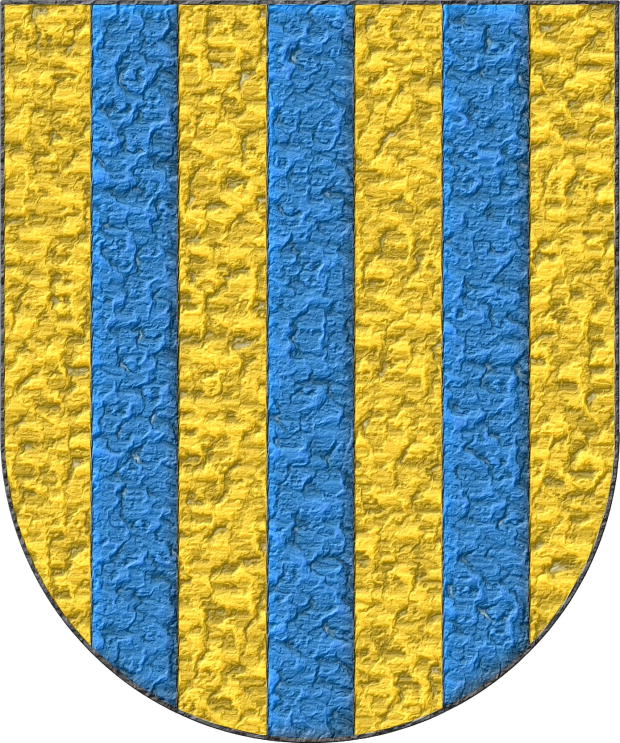
Of the twelve lineages of Noblemen, it is the first, and they bear as arms, on a golden field, three pales Azure.
Or, three Pallets Azure.
Escudo de oro, tres palos de azur.
Coat of arms interpreted with: a semicircular (round) base; the field in flat Or; the pales outlined in Sable and illuminated in Azure enamel; and finished in highly-hammered metal.
Based on the first coat of arms of the «ricoshombres» of Navarre in [Bosque, J. del; 1540; folio 1 of the numbering of 1613] and the text is from the transcription made in [Martinena Ruiz, J. J.; 1982; pages 122 and 123].
Under the title «Los Almorauides» it can also be consulted in [Vega, P. J. de; 1702; folio 1 of the manuscript].
Blazon keywords: Without divisions, Or, Three, Pale and Azure.
Style keywords: Semi-circular, Illuminated, Outlined in sable and Hard metal.
Classification: Interpreted, Personal and Kingdom of Navarre.
Bearer: Almorrabides of Navarre.


Aybar of Navarre
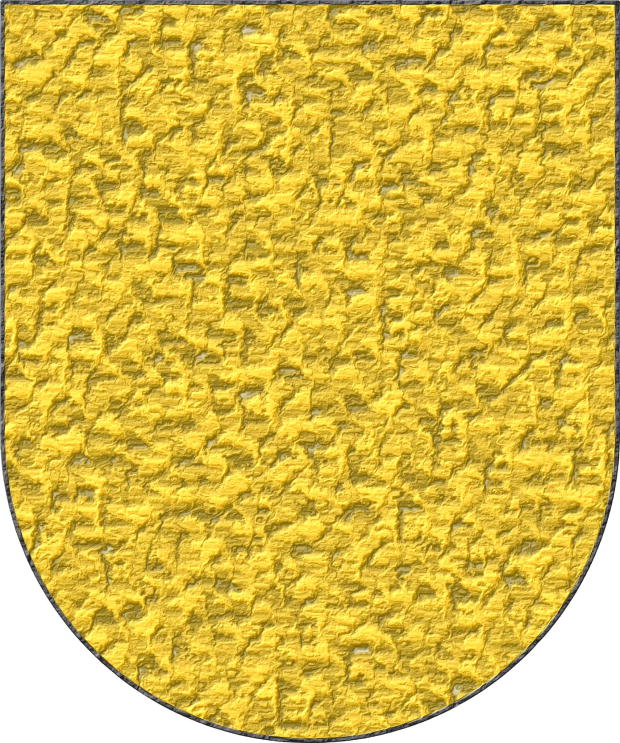
Of the twelve lineages of Noblemen, they are the third great and ancient barony, where the first King of Aragon had his mother; they make a shield of Or without any mixture of colour or device, but a field of gold as painted in this shield.
Or.
Escudo de oro.
A coat of arms that leaves little room for interpretation, which I have recreated with: a semicircular (round) base; the field in flat Or; and finished in highly-hammered metal.
Based on the third coat of arms of the «ricoshombres» of Navarre from [Bosque, J. del; 1540; folio 1 of the numbering of 1613] and the text is from the transcription made in [Martinena Ruiz, J. J.; 1982; pages 122 and 123].
Under the title «Surname of Aybar» it can also be consulted in [Vega, P. J. de; 1702; folio 3 of the manuscript].
Blazon keywords: Without divisions and Or.
Style keywords: Semi-circular, Illuminated, Outlined in sable and Hard metal.
Classification: Interpreted, Personal and Kingdom of Navarre.
Bearer: Aybar of Navarre.


Balaguer, municipality of
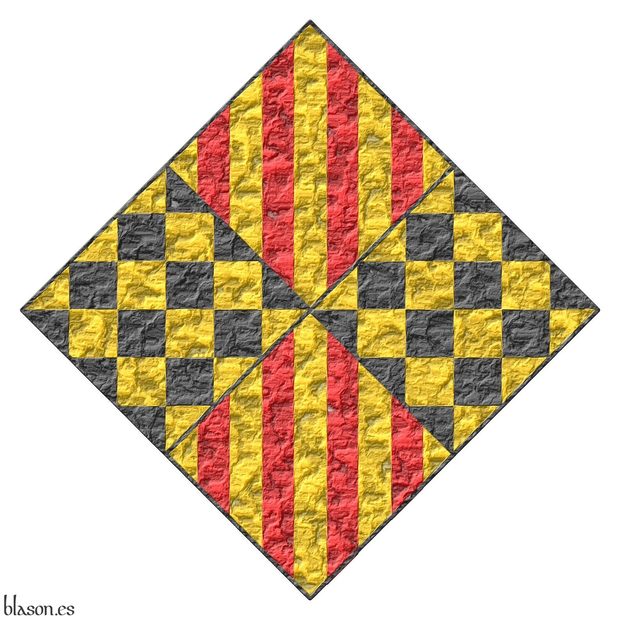
Quarterly per saltire: 1 and 4 Or, four pallets Gules; 2 and 3 chequey Or and Sable.
Escudo cuartelado en sotuer: 1o y 4o de oro, cuatro palos de gules; 2o y 3o ajedrezado de oro y sable.
Arms interpreted with: a lozenge-shaped shield; all tinctures in flat Or, Gules, and Sable; and a heavily beaten metal finish.
Balaguer is the capital of the comarca of La Noguera in the province of Lleida. It was the capital of the county of Urgell under Ponce I of Urgell.
The quartering per saltire, which could also be called quartered in cross, is defined in English as «per saltire», [The Heraldry Society; 2013; page 8].
Blazon keywords: Quarterly per saltire, Pale, Chequey, Or, Gules and Sable.
Style keywords: Tiled, Plain tincture and Hard metal.
Classification: Interpreted, Civic, Coat of arms and Kingdom of Aragon.
Bearer: Balaguer, municipality of.


Baztanes of Navarre
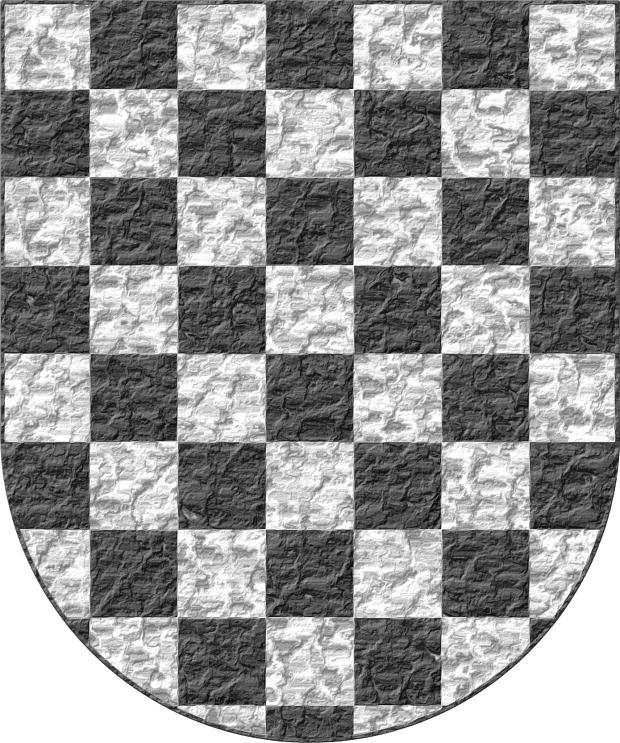
Of the twelve lineages of Noblemen, it is the fourth, and they bear as arms a chessboard, that is, a field chequy Argent and Sable, which is black, in the same form and design as this shield is now painted.
Chequey Argent and Sable.
Escudo ajedrezado de plata y sable.
Coat of arms recreated with: a semicircular (round) base; the field in flat Argent; the chequy or checky pattern illuminated in Sable; and finished in highly-hammered metal.
Coat of arms based on the fourth of the Navarrese «ricoshombres» from [Bosque, J. del; 1540; folio 1 of the numbering of 1613], but, unlike the original, adjusting the height of each square to its width so that they are perfect squares, since in Juan del Bosque’s version—actually in its copy, because the original was stolen—they appear somewhat narrow and elongated. The text heading this article is taken from the transcription made by [Martinena Ruiz, J. J.; 1982; pages 122 and 123].
Under the title «Surname of Baztan» it can also be consulted in [Vega, P. J. de; 1702; folio 4 of the manuscript], although in this case the numbering is not clearly legible; it is the folio following 3, preceding the one also numbered 4 but marked with a letter B, which in turn is followed by folio 6, the number 5 being missing — though not folio 5, which would be 4B.
Baztanes and the Valley of Baztan are mentioned in [Garaycoa Raffo, L.; 2011; pages 8, 29, 30, 33, 37, and 38].
The geometric construction of this coat of arms can be found in [Messía de la Cerda y Pita, L.; 1990; page 108].
Blazon keywords: Without divisions, Or, Chequey and Sable.
Style keywords: Semi-circular, Illuminated and Hard metal.
Classification: Interpreted, Personal and Kingdom of Navarre.
Bearer: Baztanes of Navarre.


![Ver [Chequey, chequy or checky] en criterios utilizados. Unicornio saltante sobre la divisa, criterio.](../css/Unicornio.Criterio.png)
Chequey, chequy or checky
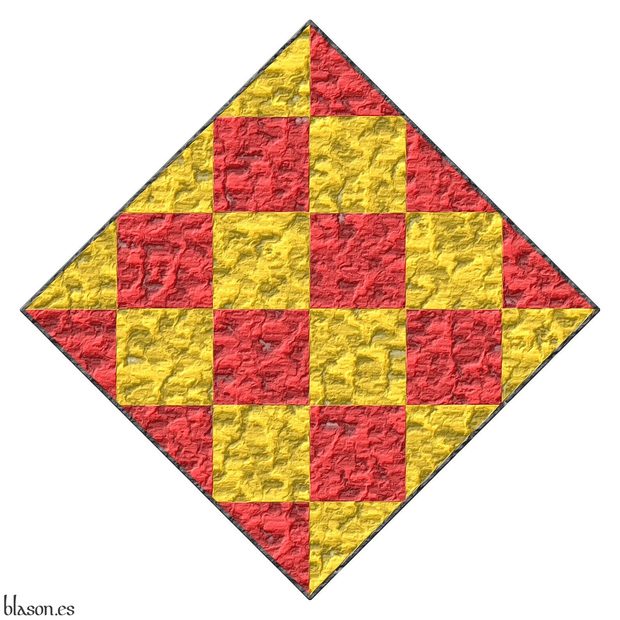
Chequey.
Chequey Or and Gules.
Escudo ajedrezado de oro y gules.
I have encountered several ways of writing the term «chequey» in English, such as «chequy», removing one «e», or «checky», and even other variants like «checkered», «checkie», «chequered», «cheque», «cheques» or «checquy».
[The Heraldry Society; 2013; pages 8 and 11] uses the term «chequey», and that is the one I strive to use.
Categories: Criterion, Tiled, Plain tincture, Hard metal, Chequey, Or and Gules.


Clement V
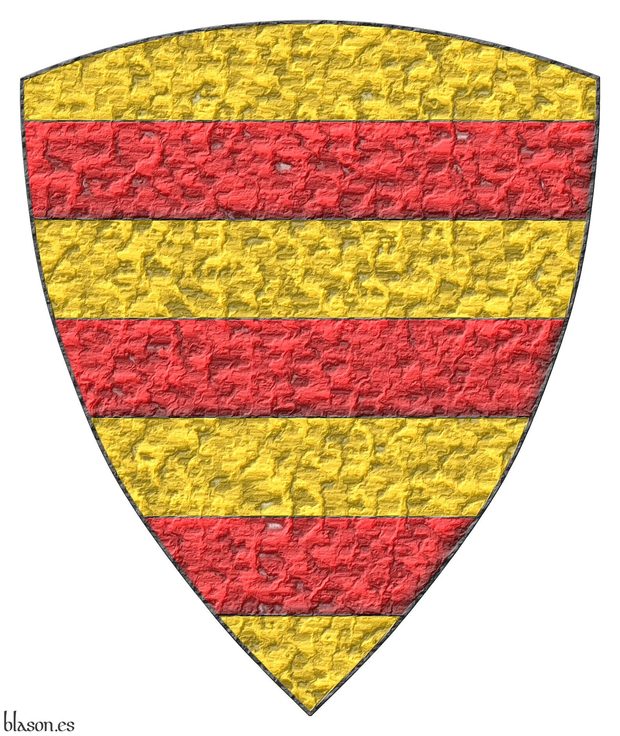
195th Pope of the Church, from 1305 to 1314. «Clemens V», born Bertrand de Got, born in Villandraut, in the southwest of France, was the first pope to reside in Avignon in a stable manner.
Or, three fesses Gules.
Escudo de oro, tres fajas de gules.
Papal coat of arms interpreted with: a rounded triangular top; the field in plain Or enamel; the bars illuminated in Gules and outlined in Sable; and with a heavily hammered metal finish.
Blazon keywords: Without divisions, Or, Three, Fess and Gules.
Style keywords: Triangular curved, Illuminated, Outlined in sable and Hard metal.
Classification: Interpreted, Religious and Papal States.
Bearer: Clement V.
Blazon equivalent to: Fernández de Córdoba y Carrillo, Diego.


Ermengol IX of Urgell
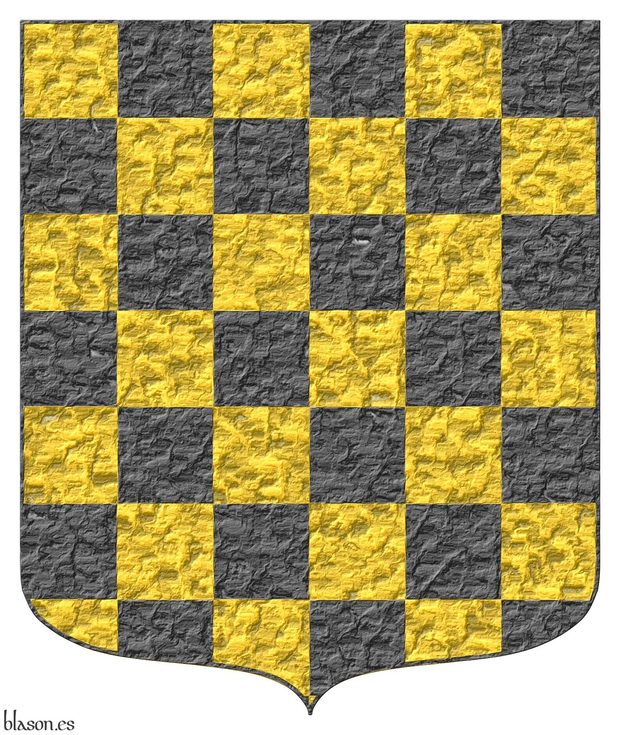
Count of Urgell, Viscount of Àger, deceased in 1243.
Chequey Or and Sable.
Escudo ajedrezado de oro y sable.
Arms interpreted with: a pointed and rounded shield shape; the chequey pattern enamelled in flat Or and Sable; and a heavily beaten metal finish.
Ermengol IX held the county for a very short time, as he died shortly after the death of his father Ponce I of Urgell, in that same year of 1243.
Blazon keywords: Chequey, Or and Sable.
Style keywords: Ogee, Plain tincture and Hard metal.
Classification: Interpreted, Personal, Coat of arms and Kingdom of Aragon.
Bearer: Ermengol IX of Urgell.


Guebara of Navarre
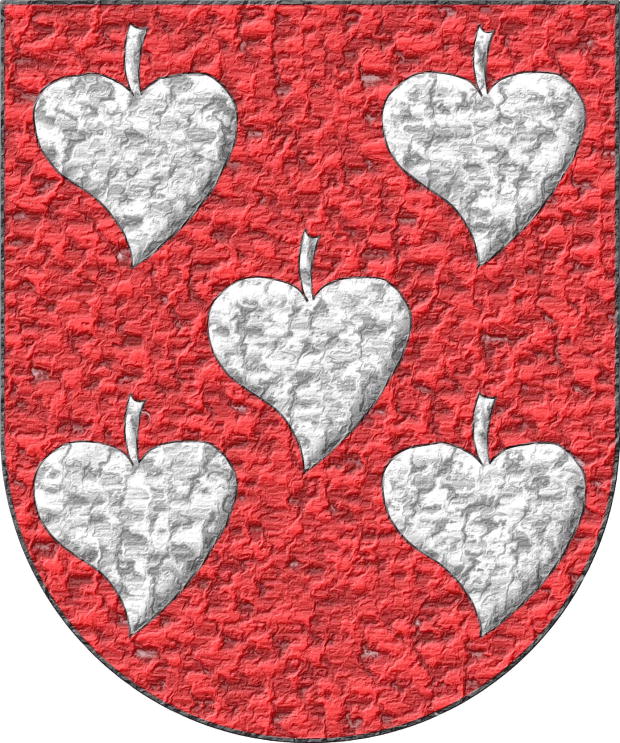
Of the twelve lineages of Noblemen, it is the second, descendant of Álava, the very ancient and powerful one, in which some served under Navarre, and others under the kings of Castile; they bear for arms and insignia, on a field Gules, which is red, five poplar-leaves (panelas) Argent, in the form and design in which this shield is painted.
Gules, five Poplar-leaves Argent, inverted.
Escudo de gules, cinco panelas de plata.
Coat of arms interpreted with: a semicircular (round) base; the field in flat Or; the pales outlined in Sable and illuminated in Azure enamel; and finished in highly-hammered metal.
Interpretation based on the second coat of arms of the «ricoshombres» of Navarre from [Bosque, J. del; 1540; folio 1 of the numbering of 1613] and the accompanying text is from the transcription made in [Martinena Ruiz, J. J.; 1982; pages 122 and 123].
The «panela» is a figure typical of Spanish heraldry [Valero de Bernabé, L.; 2007; page 11]. It is a leaf shaped like a heart with its stalk pointing upward. It could be a leaf of a tree such as, for example, the poplar, although there is no certainty that it is specifically that tree.
With first appearances prior to heraldry on Hispano-Roman tombstones, the «panela» is of Alavese origin, [Menéndez Pidal de Navascués, F.; 1985; page 474], spreading through the Basque-Navarrese region and from there throughout Spain, with the peculiar name «panela», which was initially called «pannella», [Valverde Ogallar, P. B.; 2001; page 532] derived from «pan», [Real Academia Española; 2001].
In the heraldry of other countries, leaves from different trees are used as heraldic symbols, but usually with the stalk pointing downward; therefore I transcribe in this blazon «panelas» ~ «Poplar-leaves, inverted».
[Menéndez Pidal de Navascués, F.; 1985; page 474] states that the «panela» is a natural figure equivalent to the linden leaf in German heraldry, with the stalk downward, and to the water-lily leaf in French heraldry, with the stalk upward; but since these are such different plants, I do not find it suitable to use linden, and even less water-lily, in the English transcription of this Navarrese blazon.
Under the title «Surname of Guebara» it can be consulted in [Vega, P. J. de; 1702; folio 2 of the manuscript].
Blazon keywords: Without divisions, Gules, Poplar leaf and Argent.
Style keywords: Semi-circular, Illuminated, Outlined in sable and Hard metal.
Classification: Interpreted, Personal and Kingdom of Navarre.
Bearer: Guebara of Navarre.


Holy Trinity
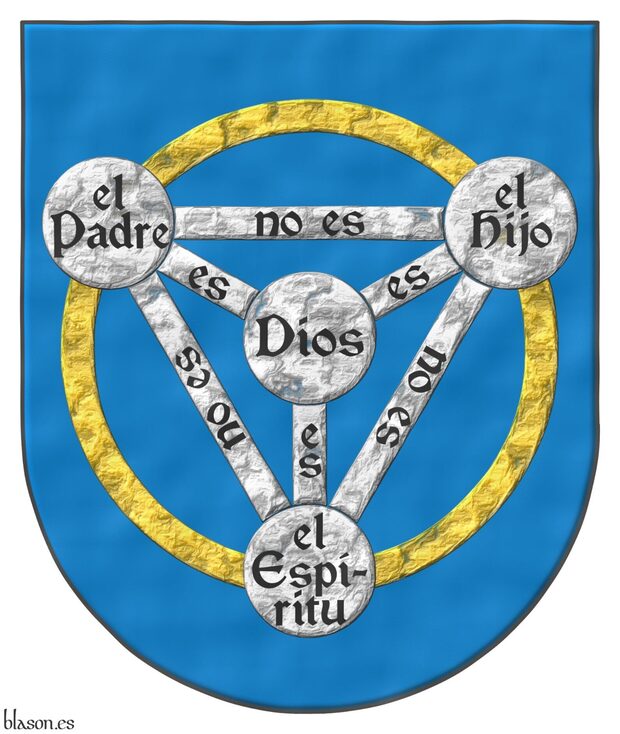
Azure, a pall couped Argent, its three arms charged with «es» Sable, within a triangle reversed Argent, its three arms charged with «no es» Sable, within an annulet Or, all debruised by four plates, three on the vertex of the triangle, in dexter chief, charged with «el Padre» Sable, in sinister chief, charged with «el Hijo» Sable, in base, charged with «el Espítiru» Sable, and one on the fess point, charged with «Dios» Sable.
Escudo de azur, una perla recortada de plata, sus tres brazos cargados con «es» de sable, dentro de un triángulo ranversado de plata, sus tres brazos cargados con «no es» de sable, dentro de un anillo de oro, todo resaltado de cuatro bezantes de plata, tres sobre los vértices del triángulo, en la diestra del jefe, cargado de «el Padre» de sable, en la siniestra del jefe, cargado con «el Hijo» de sable, en la punta, cargado con «el Espítiru» de sable y uno sobre el corazón, cargado con «Dios» de sable.
Imaginary coat of arms that I have interpreted as follows: its base is semicircular (round); its field is illuminated in watercolor Azure; the rest in heavily beaten metal, outlined of the field and illuminated in Argent, except for the annulet which is illuminated in Or; and its letters all in plain Gules ink.
Annulet
The circular crown when it is large and in the middle of the shield [Cadenas y Vicent, V. de; 1975] is called an annulet. [Avilés, J.; 1780a; pages 296 and 297] calls it annulet or small annulet depending on its size, if it is large an annulet and if it is small a small annulet. In English and French heraldry it is called «cyclamor» and hence the expression «cyclamor annulet» can also be found.
This annulet is my aesthetic contribution to this imaginary coat of arms as it is normally not represented with this annulet.
Bordure and Orle
In other interpretations the words «non est» go on a bordure or on an orle, the latter being the case blazoned, for example, [Husenbeth, F. C.; 1882; 2nd appendix] in the following way: «Gules, an orle and pall Argent, conjoined and surmounted of four plates, occupying the dexter and sinister chief and the base and fess points respectively; the first inscribed Pater, the second Filius, and the third Spiritus Sanctus, the centre Deus; the connecting portions of the orle between them having the words non est, and those of the pall est».
Blazon keywords: Without divisions, Azure, Cyclamor, Pall, Closed, Argent, Charged, Bezant and plate, Or, Dexter, Sinister, Chief, Base (lower 1/3) and Heart.
Style keywords: Semi-circular, Illuminated, Outlined in the field tincture, Watercolor and Hard metal.
Classification: Religious, Interpreted, Imaginary and Coat of arms.
Imaginary bearer: Holy Trinity.


James II of Urgell
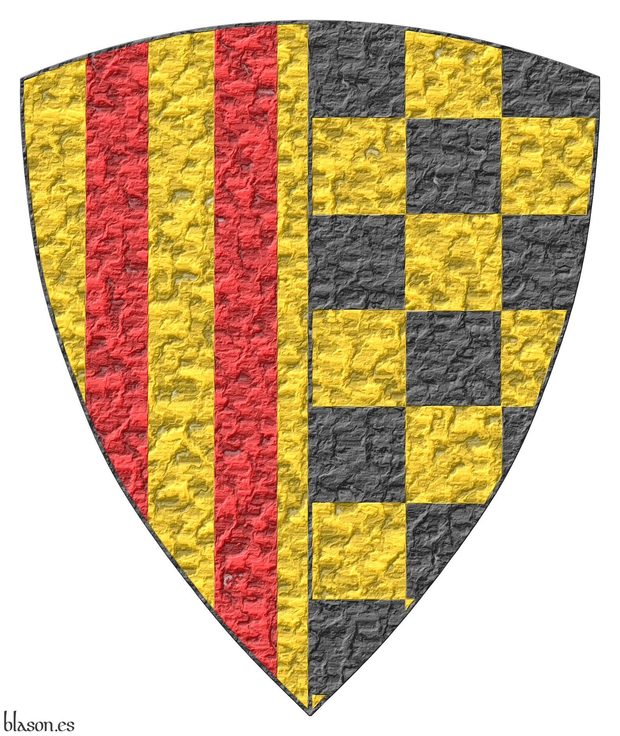
Known as the Unfortunate, Count of Urgell, Viscount of Àger, Baron of Fraga, Antillón and Alcolea de Cinca (1380–1433).
Dimidiated: 1 Or, four pallets Gules; 2 chequey Or and Sable.
Escudo dimidiado: 1o de oro, cuatro palos de gules; 2o ajedrezado de oro y sable.
Arms interpreted with: a shield shape of convex-sided triangles; the tinctures of the pallets and the chequey are flat gold, gules and sable; and the whole design has a heavily hammered metal finish.
James II of Urgell, 1380–1433, known as the Unfortunate, Count of Urgell, Viscount of Àger, and Baron of Fraga, Antillón and Alcolea de Cinca, was one of the main claimants to the throne after the death of Martin I of Aragon. His rejection of the Compromise of Caspe led to his defeat and imprisonment.
Blazon keywords: Dimidiated, Pale, Chequey, Or, Gules and Sable.
Style keywords: Triangular curved, Plain tincture and Hard metal.
Classification: Interpreted, Personal, Coat of arms and Kingdom of Aragon.
Bearer: James II of Urgell.


Lete of Navarre
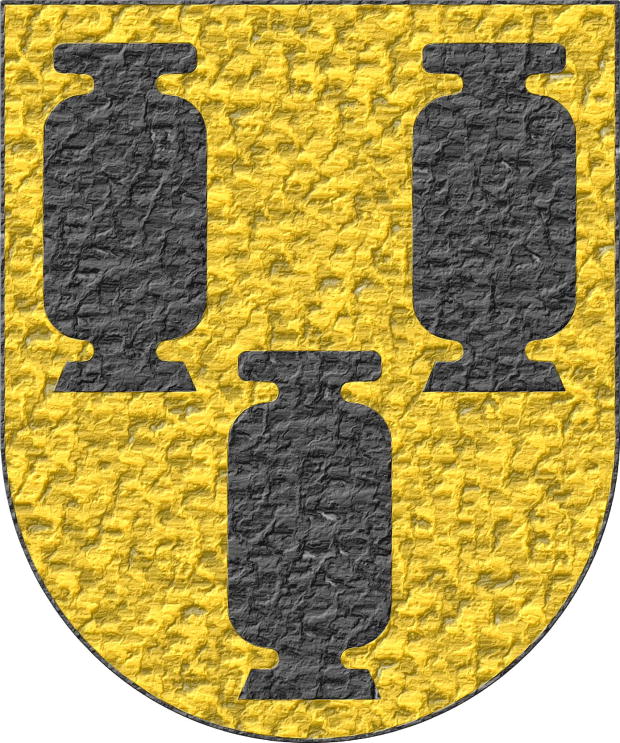
Of the twelve lineages of Noblemen, the sixth is that of Lete, from which descended Don Juan Corbarán de Let: they bear as arms, on a field Or, three pots shaped like cauldrons, slightly elongated, as painted in this shield.
Or, three Fleshpot Sable.
Escudo de oro, tres potes de sable.
Coat of arms interpreted with: a semicircular (round) base; the field in flat Or metal; the three pots illuminated in Sable with vertical, but not horizontal symmetry; and finished in highly-hammered metal.
It is not easy to find in English a similar figure:
- it could be considered «pote» ~ «pot», although perhaps «pot» is too generic,
- another possibility is «pote» ~ «fleshpot», which, although usually represented with three legs instead of a base and with two handles, is the one I tend to prefer,
- the English term «cauldron», but this corresponds to our «caldero» ~ «cauldron».
Coat of arms based on the sixth of the Navarrese «ricoshombres» from [Bosque, J. del; 1540; folio 1 of the numbering of 1613]. The text heading this article is taken from the transcription made by [Martinena Ruiz, J. J.; 1982; pages 122 and 123].
Although I have not found any reference about it, it could be considered that originally they might have been canting arms and that these three «potes» could have been milk pots, in reference to their bearers «Lete».
Under the title «Surname of Let» it can also be consulted in [Vega, P. J. de; 1702; folio 6 of the manuscript], although the number has been altered, possibly having been a 5 and perhaps interpreted as an 8, it is deduced by being placed after folio 7.
Blazon keywords: Without divisions, Or, Clay pot and Sable.
Style keywords: Semi-circular, Illuminated and Hard metal.
Classification: Interpreted, Personal, Kingdom of Navarre and Canting.
Bearer: Lete of Navarre.


Lucius III
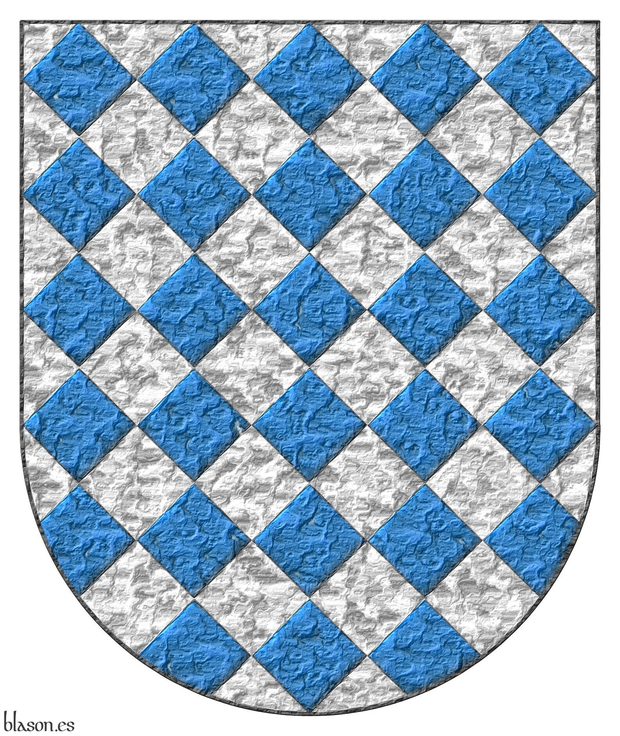
171st Pope of the Church, from the year 1181 to the year 1185. «Lucius III», born Ubaldo Allucinoli, was born in Lucca in northwest Italy.
Lozengy Argent and Azure.
Escudo losanjado de plata y azur.
Papal coat of arms interpreted by me with: a semicircular shield shape; a plain Argent field; checky or squares illuminated in Azure and outlined in Sable; and the whole design with a watercolor finish.
Blazon keywords: Without divisions, Lozengy, Argent and Azure.
Style keywords: Semi-circular, Illuminated, Outlined in sable and Hard metal.
Classification: Interpreted, Religious and Papal States.
Bearer: Lucius III.


Mauleón of Navarre
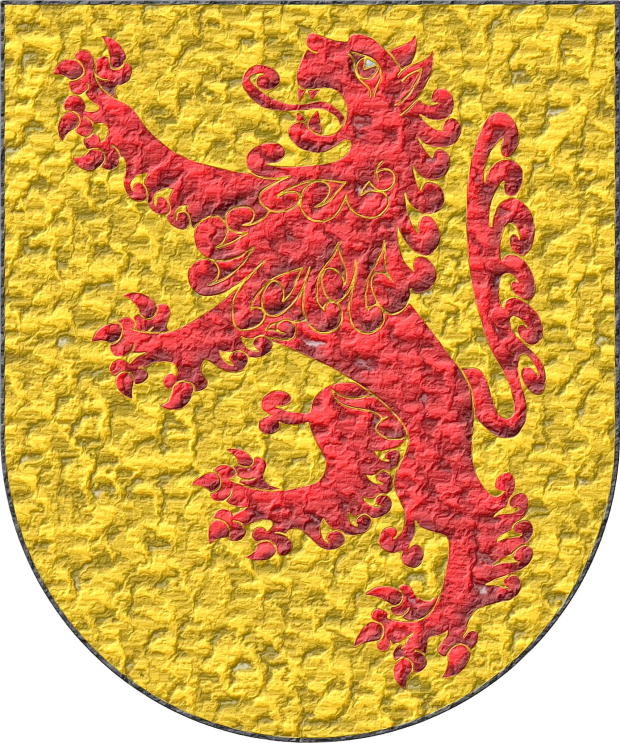
Of the twelve lineages of Noblemen, the twelfth bears as insignia and arms, on a shield Or, a rampant lion Gules, as painted in this shield.
Or, a Lion Gules, rampant.
Escudo de oro, un león de gules, rampante.
Coat of arms interpreted with: a semicircular (round) base; the field in flat Or; the lion illuminated in Gules and outlined in the colour of the field, that is, in Or metal; and the whole finished in highly-hammered metal.
Coat of arms interpreted from the last of the shields of the Navarrese «ricoshombres» illustrated in [Bosque, J. del; 1540; folio 1 of the numbering of 1613] and with the text preceding the blazon taken from the transcription by [Martinena Ruiz, J. J.; 1982; pages 122 and 123].
I consider these to be canting arms, and that this «lion» Gules refers to its bearers «Mauleón».
Under the title «Surname of Mauleon», without an accent on the letter «o», it can be consulted in [Vega, P. J. de; 1702; folio 12 of the manuscript].
Blazon keywords: Without divisions, Or, Lion, Gules and Rampant.
Style keywords: Semi-circular, Illuminated, Outlined in sable and Hard metal.
Classification: Interpreted, Personal, Kingdom of Navarre and Canting.
Bearer: Mauleón of Navarre.


Monteagudo of Navarra
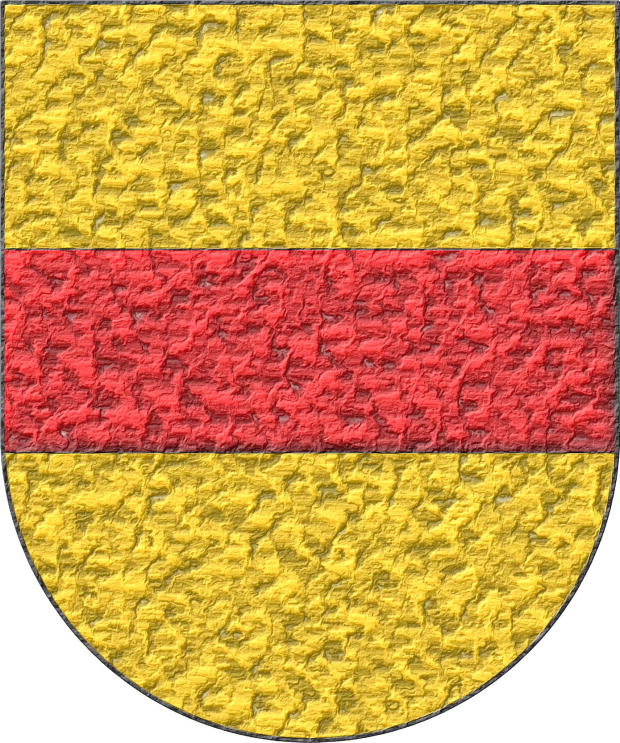
Of the twelve lineages of Noblemen, the eleventh is the house of Monteagudo; they bear as arms a shield Or, and in the middle a fess Gules, in the manner in which this shield is painted.
Or, a fess Gules.
Escudo de oro, una faja de gules.
Coat of arms interpreted as follows: a semicircular (round) base; the field enamelled in flat Or; the fess outlined in Sable and illuminated in Gules; and the whole finished in highly-hammered metal.
Interpreted from the eleventh coat of arms of the Navarrese «ricoshombres» from [Bosque, J. del; 1540; folio 1 of the numbering of 1613] and with the preceding text taken from the transcription appearing in [Martinena Ruiz, J. J.; 1982; pages 122 and 123].
Under the title «Surname of Monteagudo» this blazon can be consulted in [Vega, P. J. de; 1702; folio 11 of the manuscript].
Blazon keywords: Without divisions, Or, Fess and Azure.
Style keywords: Semi-circular, Illuminated, Outlined in sable and Hard metal.
Classification: Interpreted, Personal and Kingdom of Navarre.
Bearer: Monteagudo of Navarra.


Peter II of Urgell
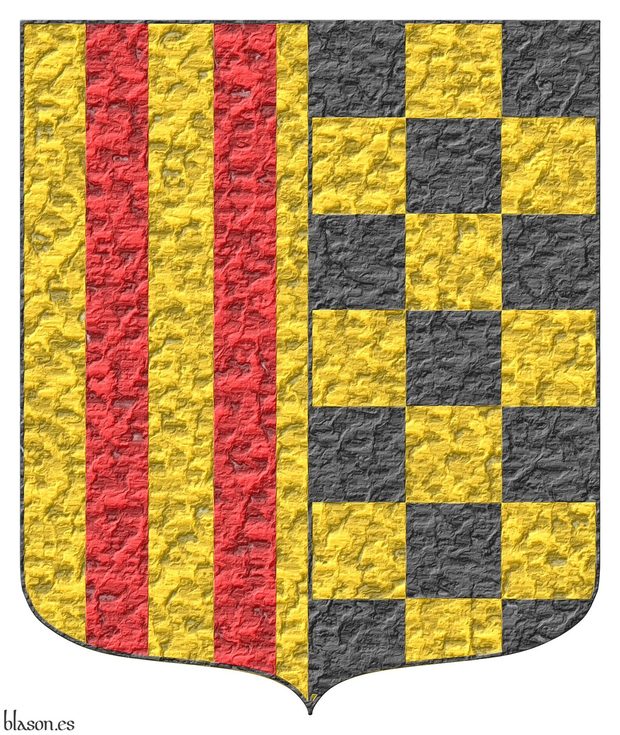
Count of Urgell, Viscount of Àger, Baron of Entença, Antillón, and Alcolea de Cinca (1340–1408).
Dimidiated: 1 Or, four pallets Gules; 2 chequey Or and Sable.
Escudo dimidiado: 1o de oro, cuatro palos de gules; 2o ajedrezado de oro y sable.
Arms interpreted with: the escutcheon in a pointed and rounded shape; the tinctures of the pales and the chequey rendered in flat inks Or, Gules, and Sable; and the whole finished with a highly hammered metal effect.
Peter II of Urgell (1340–1408), Count of Urgell, Viscount of Àger, and Baron of Entença, Antillón, and Alcolea de Cinca, was a prominent figure of 14th-century Catalan nobility and grandson of Alfonso IV of Aragon.
Blazon keywords: Dimidiated, Pale, Chequey, Or, Gules and Sable.
Style keywords: Ogee, Plain tincture and Hard metal.
Classification: Interpreted, Personal, Coat of arms and Kingdom of Aragon.
Bearer: Peter II of Urgell.


Ponce I of Urgell
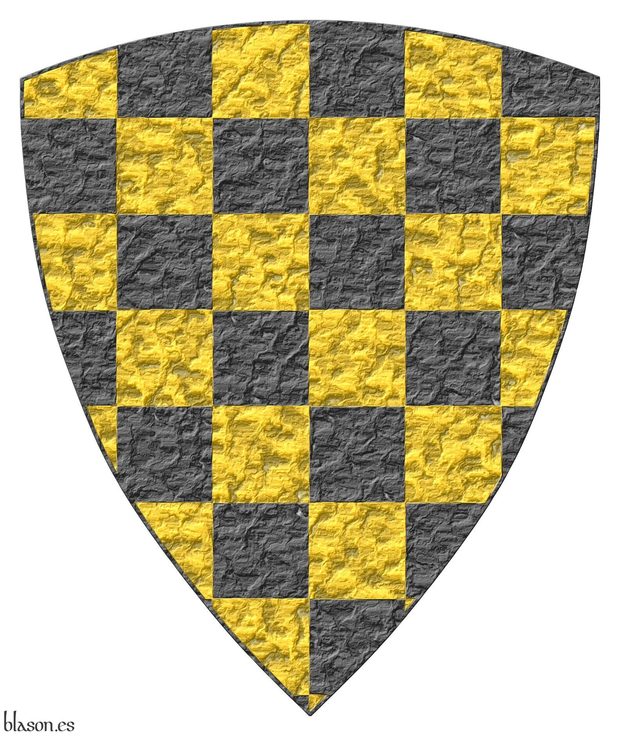
Count of Urgell, Viscount of Àger, deceased in 1243.
Chequey Or and Sable.
Escudo ajedrezado de oro y sable.
Arms interpreted with: a shield shaped as a triangle with curved sides; the chequey pattern in flat metal Or and colour Sable; and a heavily beaten metal finish.
[Avilés, J.; 1780a; page 286] states that he will call «Chequey those ordinaries composed of these small squares, which alternate between metal and colour, or vice versa, just like the boards of those Games.» and he also writes regarding the usual number of panes that «it must have six ranks or rows of these squares, though it is not necessary to specify their number, or at least the shield must include more than fifteen panes; it is only required, to properly blazon it, to always observe the first square, which is in the chief dexter; so that, if this is Or, and the one that follows is Gules, it is said to be Chequey Or and Gules, and so with other colours and metals.»
Although Ponce initially proclaimed himself count of the county of Urgell without sufficient rights, the death of the legitimate heiress and his agreements and assistance to king James I of Aragon enabled him to legalise his title. During this process, the capital of the county ceased to be the municipality of Balaguer only to eventually become it once again.
Blazon keywords: Chequey, Or and Sable.
Style keywords: Triangular curved, Plain tincture and Hard metal.
Classification: Interpreted, Personal, Coat of arms and Kingdom of Aragon.
Bearer: Ponce I of Urgell.


Qasqante of Navarre
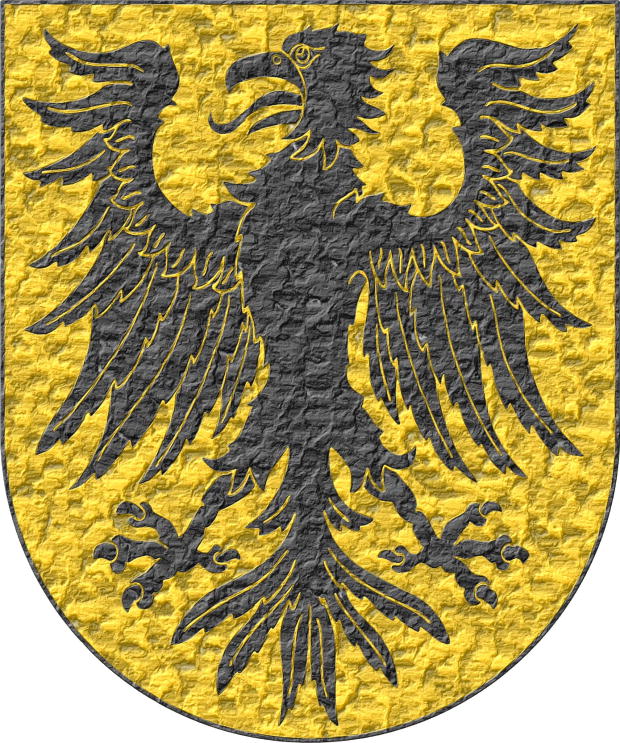
Of the twelve lineages of Noblemen, the tenth is that of Qasqante; they bear as arms a shield Or and, on the shield, an eagle Sable, which is black, as it is now painted.
Or, an Eagle displayed Sable.
Escudo de oro, un águila de sable.
Coat of arms interpreted with: a semicircular (round) base; the field in flat Or; the eagle outlined in the colour of the field and illuminated in Sable; and finished in highly-hammered metal.
Based on the tenth coat of arms of the Navarrese «ricoshombres» from [Bosque, J. del; 1540; folio 1 of the numbering of 1613] and the text is from the transcription made by [Martinena Ruiz, J. J.; 1982; pages 122 and 123].
Under the title «Surname of Cascante» it can also be consulted in [Vega, P. J. de; 1702; folio 10 of the manuscript].
Blazon keywords: Without divisions, Or, Eagle and Sable.
Style keywords: Semi-circular, Illuminated, Outlined in the field tincture and Hard metal.
Classification: Interpreted, Personal and Kingdom of Navarre.
Bearer: Qasqante of Navarre.


Rada of Navarre
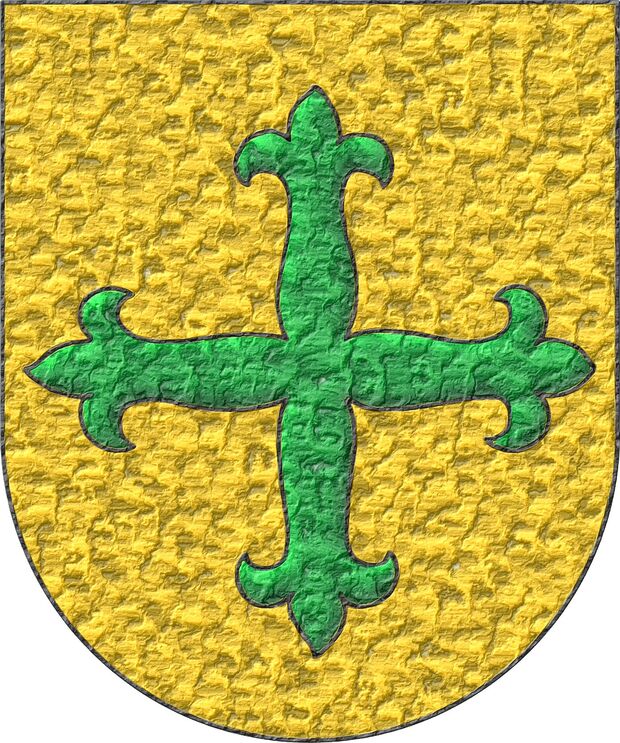
Of the twelve lineages of Noblemen, the eighth is that of Rada; they bear as arms a shield Or with a flory cross Vert, in the same manner as painted in this shield.
Or, a Cross flory Sinople.
Escudo de oro, una cruz flordelisada de sinople.
Coat of arms interpreted with: a semicircular (round) base; the field in flat Or; the flory cross outlined in Sable and illuminated in Vert enamel; and finished in highly-hammered metal.
Based on the eighth coat of arms of the Navarrese «ricoshombres» from [Bosque, J. del; 1540; folio 1 of the numbering of 1613] and the text is from the transcription made by [Martinena Ruiz, J. J.; 1982; pages 122 and 123].
Under the title «Surname of Rada» it can also be consulted in [Vega, P. J. de; 1702; folio 8 of the manuscript].
Blazon keywords: Without divisions, Or, Cross flory, Cross couped and Vert.
Style keywords: Semi-circular, Illuminated, Outlined in sable and Hard metal.
Classification: Interpreted, Personal and Kingdom of Navarre.
Bearer: Rada of Navarre.


Ramon Berenguer IV, Count of Barcelona
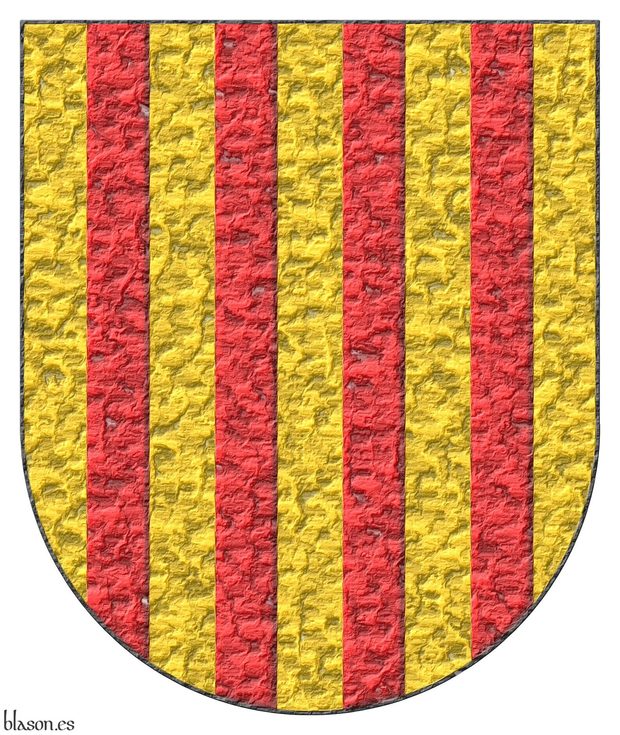
Or, four pallets Gules.
Escudo de oro, cuatro palos de gules.
Coat of arms of the Count of Barcelona interpreted by me with the following features: the escutcheon shape is semicircular; the field is rendered in flat Or; the pallets are illuminated; and the whole has been given a heavily beaten metal finish.
[Menéndez Pidal de Navascués, F.; 1988; page 537] tells us that, unlike other more territorial emblems, «from his earliest seal the pallets appear on the shield of the equestrian figures on both sides, and in line with this configuration the emblem is inherited, without distinction, by his three sons and all his grandsons... it seems one must conclude that the emblem had a familial, not territorial, character from the very beginning».
Blazon keywords: Without divisions, Or, Four, Pale and Gules.
Style keywords: Semi-circular, Illuminated and Hard metal.
Classification: Interpreted, Personal, Coat of arms and County of Barcelona.
Bearer: Ramon Berenguer IV, Count of Barcelona.


Ricardo de Mandeville, shadows of 5 + 5
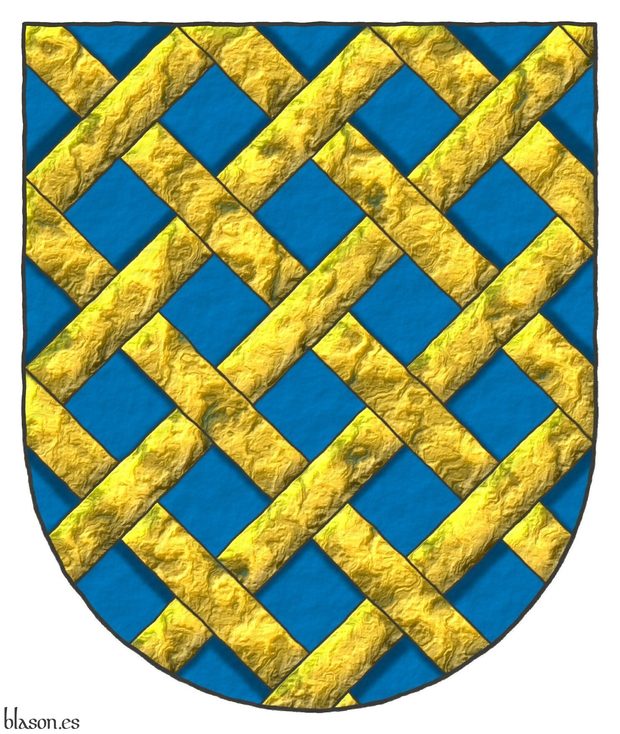
Azure fretty Or.
Escudo de azur fretado de oro.
Blazon keywords: Without divisions, Azure, Fretty and Or.
Style keywords: Semi-circular, Illuminated, Outlined in sable, Shaded, Freehand and Hard metal.
Classification: Interpreted and Personal.
Bearer: Ricardo de Mandeville.


Subiça of Navarre
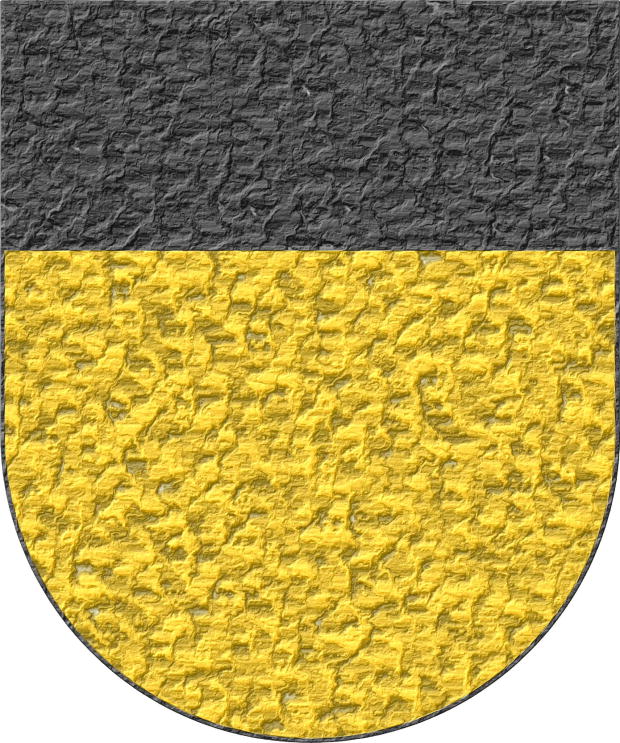
Of the twelve lineages of Noblemen, the seventh is Subiça, and bears as arms a shield Or, with a chief Sable at the upper part of the shield, in the same manner as painted in this one.
Or; a chief Sable.
Escudo de oro; el jefe de sable.
Coat of arms interpreted with: a semicircular (round) base; the field in flat Or metal; the chief in flat Sable; and the whole finished in highly-hammered metal.
Coat of arms based on the seventh of the Navarrese «ricoshombres» from [Bosque, J. del; 1540; folio 1 of the numbering of 1613]. The text heading it is taken from the transcription made by [Martinena Ruiz, J. J.; 1982; pages 122 and 123].
Under the title «Surname of Cubiza» these armorial bearings can be consulted in [Vega, P. J. de; 1702; folio 7 of the manuscript].
Blazon keywords: Without divisions, Or, Chief and Sable.
Style keywords: Semi-circular, Plain tincture and Hard metal.
Classification: Interpreted, Personal and Kingdom of Navarre.
Bearer: Subiça of Navarre.


Teresa of Entenza
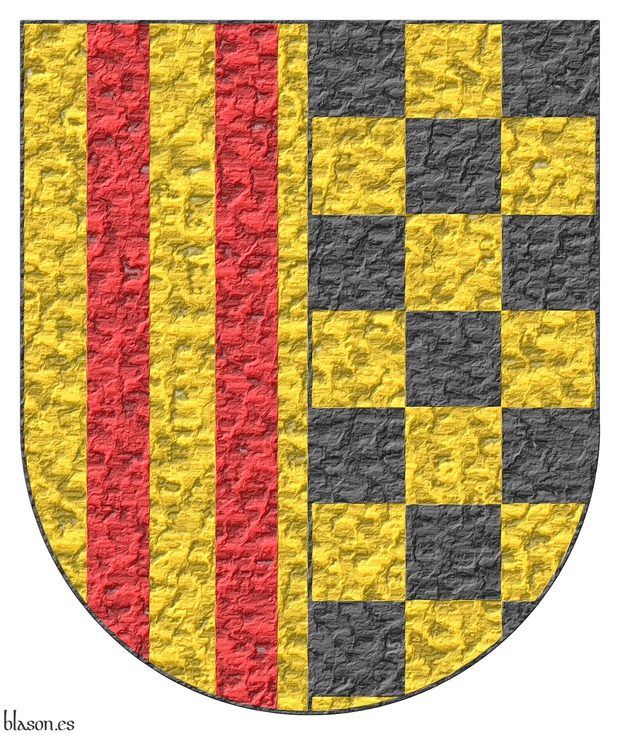
Countess of Urgell, Viscountess of Ager, Lady of Alcolea de Cinca, died in 1327.
Dimidiated: 1 Or, four pallets Gules; 2 chequey Or and Sable.
Escudo dimidiado: 1o de oro, cuatro palos de gules; 2o ajedrezado de oro y sable.
Arms interpreted with: a round-bottom shield; all tinctures in flat Or, Gules, and Sable; and a heavily beaten metal finish.
A dimidiated coat of arms is the result of combining two shields of arms by taking the dexter half of the first and the sinister half of the second.
Dimidiation was used in the 13th and 14th centuries to combine, for instance, the arms of two families.
Its blazoning method does not consist of describing what appears in each of the resulting quarters, but rather, by stating from the beginning that it is dimidiated, describing the original coats of arms. Thus, in this particular case of the arms of Teresa of Entenza, it is not stated that there are only two pallets in the first quarter, but that it is dimidiated and has four pallets, so the reader must know that from the four pallets, only the first two are visible due to the dimidiation.
This method of dimidiating the arms of predecessors results in very beautiful and original designs, but depending on the charges and figures involved, in other cases the result may be unrecognisable or even absurd.
Blazon keywords: Dimidiated, Pale, Chequey, Or, Gules and Sable.
Style keywords: Semi-circular, Plain tincture and Hard metal.
Classification: Interpreted, Personal, Coat of arms and Kingdom of Aragon.
Bearer: Teresa of Entenza.


UBU
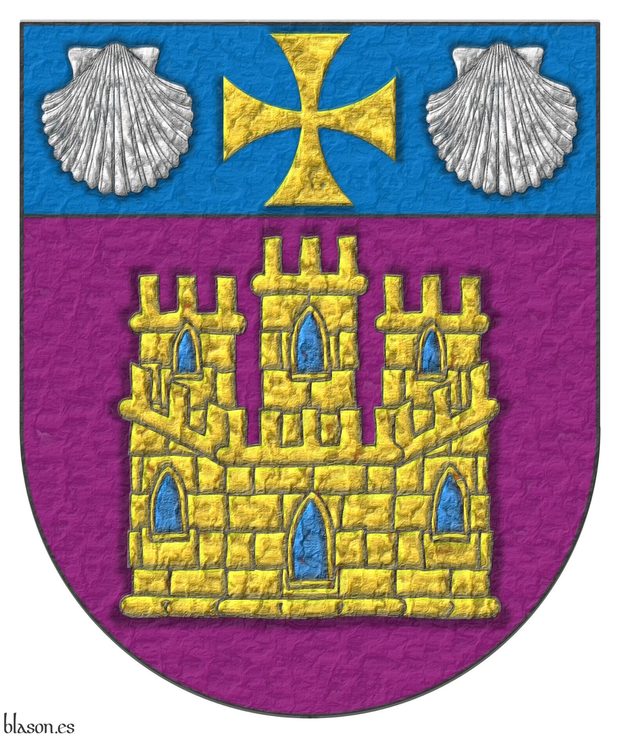
Purpure, a castle triple-towered Or, port and windows Azure, masoned Sable; on a chief Azure, a cross patty Or, between two escallops Argent.
Escudo de púrpura, un castillo de oro, aclarado de azur, mazonado de sable; un jefe de azur, cargado de una cruz patada de oro acompañada de dos veneras de plata.
Coat of arms interpreted as follows: with a semicircular (round) base; the field and the chief in the flat tinctures Purpure and Azure, with a lightly-hammered metal finish; and the four charges outlined in Sable, shaded, illuminated, and with a very hammered metal finish.
I hold the University Specialist degree in Real Estate Management and Administration, awarded by the Department of Private Law of the University of Burgos. These studies are structured over three academic years and are pursued online in combination with periods of traditional classes in the summers and on-site examinations during the winters. This was my first long-term online training experience.
Blazon keywords: Purpure, Or, Azure, Sable, Argent, Castle, Chief, Cross, Cross patty, Cross couped and Escallop.
Style keywords: Semi-circular, Illuminated, Shaded, Outlined in sable, Soft metal and Hard metal.
Classification: Interpreted, Socioeconomic and Education.
Bearer: Burgos, University of.


Urgell, County of
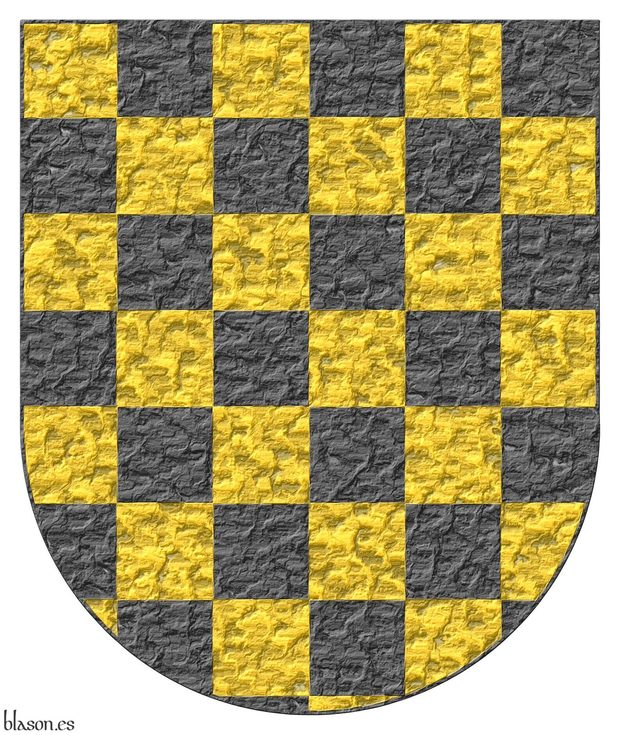
Chequey Or and Sable.
Escudo ajedrezado de oro y sable.
Arms interpreted with: a round-topped shield shape; the chequey pattern in flat metal Or and colour Sable; and a heavily beaten metal finish.
[Avilés, J.; 1780a; page 33] writes about the application of the chequey pattern to shields, ordinaries and charges: «chequey is said of the shield, the principal ordinaries, and even some animals, such as eagles, lions, and other charges, when they are composed of alternating square pieces in the fashion of a chessboard.» On the minimum number of panes he generally specifies that «for a shield to be called chequey, it must have at least twenty chessboard panes; because if it has only nine, it is called equipoll; and if it has fifteen, it is said to be of fifteen panes of chequey» and for its application to ordinaries that «other ordinaries, such as bends, fesses, etc., must have at least two rows of chequey to be considered chequey, otherwise they would be called compony.»
Blazon keywords: Chequey, Or and Sable.
Style keywords: Semi-circular, Plain tincture and Hard metal.
Classification: Interpreted, Civic, Coat of arms and Kingdom of Aragon.
Bearer: Urgell, County of.


Urroz of Navarre
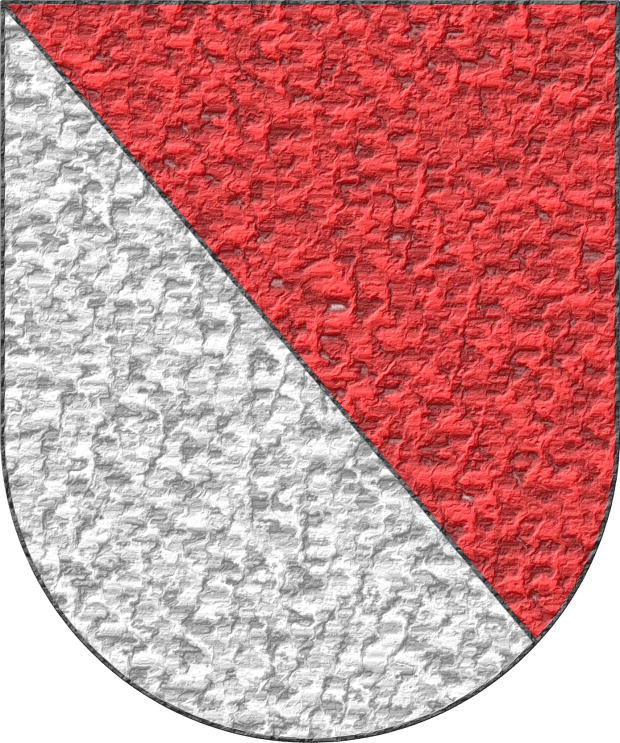
De los doce linajes de Ricos Hombres el quinto es la buena villa de Urroz, la torre blanca; y goza en armas un escudo partido por medio, de lo alto ata baxo, a manera de banda, desta forma e deuisas que en este escudo está de presente pintado.
Party per bend: 1 Gules; 2 Argent.
Escudo tronchado: 1o de gules; 2o de plata.
Coat of arms with poco margen for the interpretación con: la base of semicircular (round); el field of tintas planas of Gules and Argent; y con a finish of metal muy batido.
Coat of arms basado in the 5o of los «ricoshombres» of Navarra de [Bosque, J. del; 1540; folio 1o of the numeración of 1613]. El texto previo a su blasón está extraído of the transcripción realizada por [Martinena Ruiz, J. J.; 1982; páginas 122 and 123].
Bajo the título «Apellido of Vrroz» también puede consultarse en [Vega, P. J. de; 1702; folio 4B of the manuscrito], estando the 4 in the esquina superior izquierda and the B in the base of the coat of arms. Este folio tendría that estar numerado with a 5.
Blazon keywords: Party per bend, Gules and Sable.
Style keywords: Semi-circular, Plain tincture and Hard metal.
Classification: Interpreted, Personal and Kingdom of Navarre.
Bearer: Urroz of Navarre.


Vidaurre of Navarre
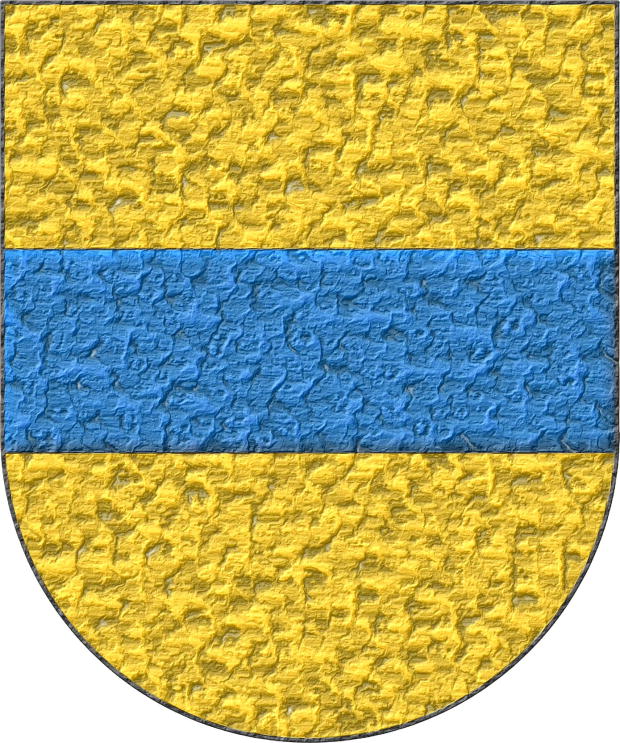
Of the twelve lineages of Noblemen, the ninth is Vidaurre, who bears as arms a shield Or and, in the middle, a fess Azure, in the same manner as this shield is now painted.
Or, a fess Azure.
Escudo de oro, una faja de azur.
Coat of arms interpreted with: a semicircular (round) base; the field in flat Or; the fess illuminated in Azure and outlined in Sable; and the whole finished in highly-hammered metal.
Interpreted from the ninth coat of arms of the Navarrese «ricoshombres» from [Bosque, J. del; 1540; folio 1 of the numbering of 1613] and with the preceding text taken from the transcription appearing in [Martinena Ruiz, J. J.; 1982; pages 122 and 123].
Under the title «Surname of Vidaurre» this coat of arms can be consulted in [Vega, P. J. de; 1702; folio 9 of the manuscript].
Blazon keywords: Without divisions, Or, Fess and Azure.
Style keywords: Semi-circular, Illuminated, Outlined in sable and Hard metal.
Classification: Interpreted, Personal and Kingdom of Navarre.
Bearer: Vidaurre of Navarre.
Blazon equivalent to: Vernon, barón de Shubbroc.
-
Language
-
Categories of heraldry
-
Divisions of the field
- Without divisions
- Party per pale
- Party per fess
- Party per bend
- Party per bend sinister
- Tierce
- Tierce sinister
- Tierced per pale
- Tierced per fess
- Tierced per bend
- Tierced pallwise inverted
- Quarterly
- Quarterly per saltire
- Gyronny
- Party per fess, the chief per pale
- Party per pale, the sinister per fess
- Party per fess, the base per pale
- Party per pale, the dexter per fess
- Chapé
- Chaussé
- Embrassé
- Contre-embrassé
- Party per chevron
- Enté
- Enté en point
- Flanched
-
Metals
-
Colours
-
Furs
-
Other tinctures
-
Ordinaries and sub-ordinaries
-
Diminutives of the ordinaries
-
Geometric charges
-
Composite ordinaries
-
Inanimate charges from Nature
Atom, Crescent, Diamond, Emerald, Estoile, Increscent, Lightning flash, Moon, Mount, Mullet, Mullet of four points, Orbital, Plough of Ursa Major, Rainbow, Ray of the sun, River, Sea, Snowflake, Sun, Sun in splendour, Sun of May, Trimount, Water and Wave.
-
Vegetal charges from Nature
Acorn, Apple, Apple tree, Ash, Bluebonnet, Camellia, Chrysanthemum, Cinquefoil, Cornflower, Dogwood flower, Double rose, Elm, Fleur de lis, Flower, Gourd, Holm oak, Hop cone, Kapok tree, Laurel, Lily, Linden, Lotus flower, Madonna lily, Mexican cedar tree, Oak, Olive tree, Palm tree, Plantain plant, Pomegranate, Poplar leaf, Rose, Shamrock, Sunflower, Thistle, Tree, Tulip, Vine and Wheat.
-
Animal charges from Nature
Badger, Bald eagle, Barbel, Barn owl, Bear, Beaver, Beetle, Bighorn sheep, Blackbird, Boar, Brach hound, Bull, Doe, Dog, Dolphin, Dove, Eagle, Elephant, Falcon, Female figure, Fish, Flame, Fly, Fox, Frog, Goat, Goldfinch, Goose, Heron, Horse, Hummingbird, Jaguar, Lark, Leopard, Lion, Lion passant, Lion rampant guardant, Lioness, Lynx, Male figure, Martlet, Merino ram, Owl, Panther, Parrot, Peacock, Pelican, Pelican in her piety, Puffin, Quetzal, Raven, Roe deer, Rooster, Savage, Seagull, Serpent, She-wolf, Stag, Starling, Talbot, Tyger, Vulture, Warren hound and Wolf.
-
Parts of natural charges
Arm, Beak, Branch, Caboshed, Chest, Claw, Covert, Dorsal fin, Eagle claw, Ermine spot, Escallop, Feather, Foot (palmiped), Foreleg, Forepaw, Hand, Head, Heart, Hoof, Leaf, Neck, Ostrich feather, Palm frond, Paw, Roe deers' attires, Shoulder, Sprig, Stags' attires, Stem, Swallow-tail, Tail, Tail addorsed, Tail fin, Talon, Tooth, Trunk, Trunk (elephant), Two hands clasped, Two wings in vol, Udder, Wheat spike, Wing and Wrist.
-
Artificial charges
Ace of spades, Anchor, Anvil, Arch, Arm vambraced, Armillary sphere, Arrow, Axe, Bell, Bell tower, Beret, Bonfire, Book, Bookmark, Bow, Branding iron, Bridge, Broken, Buckle, Cannon, Cannon dismounted, Cannon port, Canopy roof, Carbuncle, Castle, Celtic Trinity knot, Chain, Chess rooks, Church, Clarion, Clay pot, Closed book, Club, Column, Comb, Compass rose, Conductor's baton, Cord, Covered cup, Crozier, Crucible, Cuffed, Cup, Cyclamor, Dagger, Double vajra, Drum, Ecclesiastical cap, Fanon, Federschwert, Fleam, Four crescents joined millsailwise, Galician granary, Garb, Gauntlet, Geometric solid, Grenade, Halberd, Hammer, Harp, Host, Hourglass, Key, Key ward, Knight, Knot, Lantern, Letter, Line, Loincloth, Menorah, Millrind, Millstone, Millwheel, Monstrance, Mortar, Mullet of six points pierced, Nail, Non-classic artifact, Norman ship, Number, Oar, Oil lamp, Open book, Page, Pair of scales, Parchment, Pestle, Piano, Pilgrim's staff, Plough share, Polish winged hussar, Port, Portcullis, Potent, Quill, Ribbon, Rosette of acanthus leaves, Sabre, Sackbut, Sail, Scroll, Scythe, Sheaf of tobacco, Ship, Skirt, Spear, Spear's head, Stairway, Star of David, Step, Sword, Symbol, Tetrahedron, Torch, Tower, Trident, Trumpet, Turret, Two-handed sword, Wagon-wheel, Water-bouget, Wheel, Winnowing fan and With a turret.
-
Immaterial charges
Angel, Archangel, Basilisk, Dragon, Dragon's head, Garuda, Golden fleece, Griffin, Heart enflamed, Justice, Mermaid, Our Lady of Mercy, Ouroboros, Paschal lamb, Pegasus, Phoenix, Sacred Heart of Jesus, Saint George, Sea-griffin, Trinity, Triton, Unicorn, Winged hand and Wyvern.
-
External elements
-
Heraldic creations
-
References
-
Formats
-
Keywords on this page
Port and windows, Watercolor, Chequey, Alfonso VIII of Castile, Almorrabides of Navarre, Cyclamor, Aybar of Navarre, Azure, Balaguer, municipality of, Baztanes of Navarre, Bezant and plate, Burgos, University of, Charged, Castle, Closed, Clement V, County of Barcelona, Ogee, Heart, Criterion, Cross couped, Outlined in sable, Outlined in the field tincture, Dimidiated, Coat of arms, Papal States, Fess, Personal, Gules, Illuminated, Interpreted, Chief, Tiled, Semi-circular, Hard metal, Or, Pale, Canting, Argent, Without divisions, Civic, Kingdom of Aragon, Kingdom of Navarre, Religious, Sable, Shaded, Plain tincture, Three and Triangular curved.
